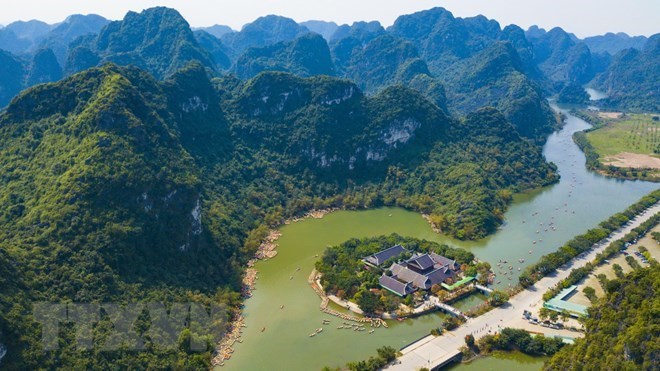Numerous events mark 1,050th anniversary of Vietnam’s first feudal state

A view of Trang An complex in Ninh Binh from above. (Photo: VNA)
The northern province of Ninh Binh will host various events this year to mark the 1,050th anniversary of the establishment of Dai Co Viet, the first feudal state of Vietnam.
The highlight will be a ceremony to celebrate the Dai Co Viet establishment and launch Hoa Lu Festival, the largest and most spectacular festival of the province slated for April 24-27 under the theme “The 1050-year journey of Dai Co Viet State in the flow of history.”
The province will also hold a wide range of cultural and sport activities and festivals in April, including an art exchange programme between Ninh Binh and Asan city (Republic of Korea), Oudomxay (Laos), Bac Lieu, Ca Mau and Tuyen Quang provinces among others, a national workshop on role of Dai Co Viet in the country’s history, art and photo exhibitions and Thai Vi Temple and Trang An festivals.
In 2018, Ninh Binh will publish books on local intangible cultural heritages and socio-economic development of the province from 2015-2018, host the beauty pageant “Miss Hoa Lu” and for the first time, organise a local tourism week promoting the beauty of the Tam Coc and Trang An complexes.
The events will provide people with a better understanding of the role and historic values of Dai Co Viet and promote signature cultural and natural beauties of Hoa Lu ancient capital, according to Pham Quang Ngoc, head of the provincial Party’s Committee Board of Information and Education.
In the late 10th century, Hoa Lu was capital and the economic, political and cultural centre of Dai Co Viet founded by Dinh Bo Linh (968-979), and then the Early Le Dynasty (980-1009).
Dai Co Viet (Great Viet) was the first centralised feudal state in Vietnam which existed from 968 to 1010 AD. It was also the native land of three royal dynasties: the Dinh, the early Le and the Ly. Hoa Lu was the first capital of the country until King Ly Thai To moved the capital to Thang Long (now Hanoi) in 1010.
In the late 10th century, Vietnam was fragmented and was later reunited by Dinh Bo Linh, who founded the Dinh Dynasty in 968 and ascended to the throne under the name Dinh Tien Hoang.
The emperor chose Hoa Lu as his capital as it was protected by the Trang An mountains on three sides and by the Hoang Long River to the northwest. With strong walls linking the limestone mountains, Hoa Lu had natural defences but also allowed the emperor’s forces to mount attacks against foes and to communicate with their subjects.
Over 42 years, the Dinh and the early Le dynasties erected palaces, temples and shrines within the centre of the nation’s city walls. Due to the ravages of time, there are only about 30 vestiges related to the dynasties remaining, including the temples of King Dinh Tien Hoang and King Le Dai Hanh and Nhat Tru Pagoda.
The 300-ha Hoa Lu ancient capital is now a popular tourist destination in Ninh Binh, famous for beautiful landscapes with magnificent lime mountains and rivers.
VNA
 Community tourism transforms livelihoods in remote areas
Community tourism transforms livelihoods in remote areas
 Agoda lists Da Lat among cheapest destinations for year-end holidays
Agoda lists Da Lat among cheapest destinations for year-end holidays
 TasteAtlas picks out two Vietnamese dishes among world’s 100 best rated crustacean dishes
TasteAtlas picks out two Vietnamese dishes among world’s 100 best rated crustacean dishes
 Vietravel expands business in Indian market
Vietravel expands business in Indian market
 2025 Nha Trang – Khanh Hoa Sea Festival to spotlight cultural heritage space
2025 Nha Trang – Khanh Hoa Sea Festival to spotlight cultural heritage space
Vietnam, a unique destination attracting Indian tourists: Indian newspaper
 Cao Bang eyes new opportunities for cross-border tourism development
Cao Bang eyes new opportunities for cross-border tourism development
 Kien Giang strives to attract tourists to finish the year on high note
Kien Giang strives to attract tourists to finish the year on high note
 Rivers provide major resources to boost Vietnam’s tourism
Rivers provide major resources to boost Vietnam’s tourism
 Dong Thap plants over 100 ha of flowers for Tet
Dong Thap plants over 100 ha of flowers for Tet



